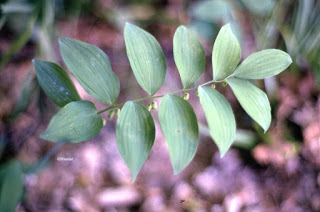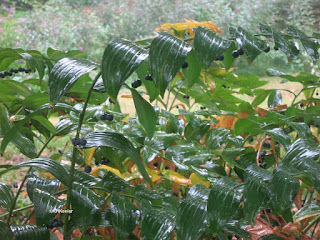 |
| goatsbeard, Tragopogon |
 |
| false salsify, Scorzonera laciniata |
 |
| Solomon's seal, Polygonatum biflorum |
 |
| Solomon's seal, Polygonatum biflorum |
 |
| false solomon's seal, Maianthemum racemosum |
 |
| false solomon's seal, Maianthemum racemosum with developing fruit |
In the past, you'd look names up in a book with a regional focus. Generally regional names agree so you'd rarely be confused and the plant in question would undoubtedly be included in the book. With the internet you can quickly cut across huge distances. It is easy to google a common name but not always easy to determine where the author of page you find is located. You need to know where the helpful writer is, because the plant you are trying to figure out might not grow in the area he or she covers or it might be known by a quite different name there.
Here's a example. Working on a Colorado mountain plant you think is a columbine (above) you go to a website with a helpful name and friendly approach (I'll try Identify That Plant link) and look for your flower. Use the Search function and find columbine. But that gets you a photo of this plant link, the red columbine. The description doesn't suggest they are ever any other color. What do you decide? That your plant isn't a columbine? If you thought it was a Colorado website, you might think that.
Columbines have a rather distinctive shape, so in fact you might make the right conclusion: the blue flower is a columbine but not the one in the picture. Identify That Plant is in North Carolina, but you have to click on About to learn that. And then you need to be knowledgeable enough to wonder how different the plants of Colorado are from those of North Carolina. Quite different, actually.
Most people don't realize that we have some 17,00 different native plant species in the continental United States. We underestimate diversity partly because we plant the same cultivated plants (daffodils, lilacs, roses, marigolds, geraniums) and a few highly successful weeds are widespread, dandelions, crabgrass, plantains, purslane, lamb's quarters, and sunflowers for example. Since these two groups of plants are visible in Boston, Philadelphia, Chicago, Denver and Los Angeles, it gives the illusion that it doesn't matter where you are, the same plants will be there. That is very much an illusion. Even my list isn't likely to really work: people in each of those cities will have to hunt for one or more of the "ubiquitous" plants I listed.
Today we can quickly compare the names given by the Flora of North America, the USDA Plants Website, and university and individual websites from all across the continent. Often the common names differ. Which can lead you very far astray or waste lots of time.
I can offer two suggestions. If you are writing online anything that mentions a plant, give its scientific name and your location. There are two plants called white sage, three bergamots, two hemlocks, two goatsbeards, while false salsify is also called viper grass, Osage orange is also bodark, and serviceberries, June berries and saskatoons are the same plant. The scientific name will make it clear which plant you are writing about. Your location will help people interpret your observations.
 |
| wild bergamot, Monarda NOT the bergamot used in Earl Grey tea |
It is not going to get better any time soon. In fact, as more and more individuals contribute to the web, as every business establishes a website, we create ever more opportunities for the online search to go astray. Learn to check where the writer of the blog or website is and to follow the trail of common names using the scientific name to keep your bearings. Then, wow, there are some wonderful websites out there!
Comments and corrections welcome.
Related posts from this blog:
when scientific names differ link
Previous posts about common names: what a mess
too many link
too many shared names link
On plants whose common names overlap: sage and sagebrush; bergamot; hemlock
Plants with too many common names mentioned above: Osage orange, serviceberry
References
Ackerfield, J. 2015. Flora of Colorado. BRIT Press, Fort Worth, Texas.
Culpeper, N. Goat's beard. Culpeper's complete herbal. Facsimilie from 1852 online. Originally published 1652. link (Curiously, two other versions of Culpeper online, where it has been retyped, at Bibliomania and www.complete-herbal.com, do not include the goat's beards.)
Grieve, M. 1931. Goat's beard. in A modern herbal. online link
Thayer, S. 2010. Nature's garden. Forager's Garden Press, Birchwood, Wisconsin.
Weber, W. A. and R. C. Whitman, 2001. Flora of Colorado eastern slope. 3rd ed. University of Colorado, Boulder.
Kathy Keeler, A Wandering Botanist
More at awanderingbotanist.com

No comments:
Post a Comment